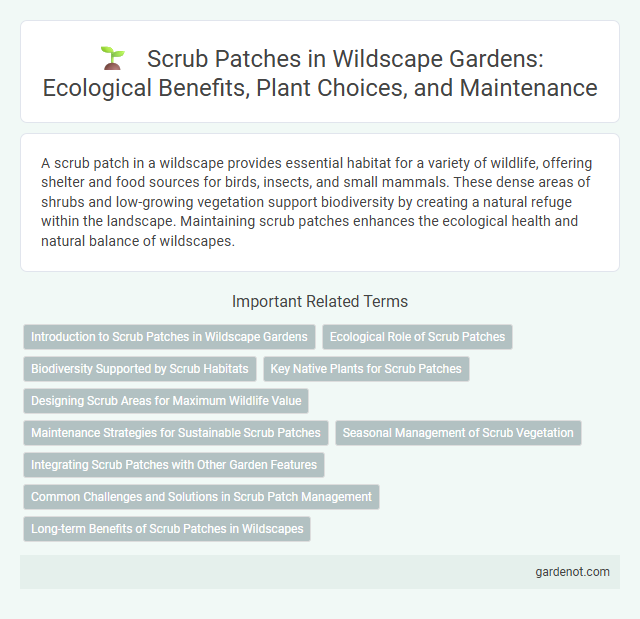A scrub patch in a wildscape provides essential habitat for a variety of wildlife, offering shelter and food sources for birds, insects, and small mammals. These dense areas of shrubs and low-growing vegetation support biodiversity by creating a natural refuge within the landscape. Maintaining scrub patches enhances the ecological health and natural balance of wildscapes.
Introduction to Scrub Patches in Wildscape Gardens
Scrub patches in Wildscape gardens provide essential habitat for diverse wildlife, supporting species like insects, small mammals, and birds. These dense, shrubby areas promote biodiversity by offering food sources, shelter, and nesting sites within the ecosystem. Maintaining scrub patches helps preserve natural balance and enhances the ecological value of garden landscapes.
Ecological Role of Scrub Patches
Scrub patches serve as vital habitats supporting biodiversity by providing shelter and nesting sites for numerous bird species, small mammals, and insects in wildscapes. These areas contribute to soil stabilization and nutrient cycling, enhancing ecosystem resilience against erosion and climate variations. Their dense vegetation structure also acts as corridors for wildlife movement, maintaining ecological connectivity across fragmented landscapes.
Biodiversity Supported by Scrub Habitats
Scrub habitats in wildscapes play a crucial role in supporting biodiversity by providing shelter and food sources for a variety of species, including birds, insects, and small mammals. These areas act as vital ecological niches, enabling pollinators like bees and butterflies to thrive while supporting nesting sites for ground-nesting birds. The structural complexity of scrub patches enhances habitat diversity, promoting species richness and ecosystem resilience.
Key Native Plants for Scrub Patches
Key native plants for scrub patches include species such as scrub oak (Quercus ilicifolia), blueberry (Vaccinium spp.), and wild rosemary (Conradina canescens), which thrive in well-drained, sandy soils typical of these habitats. These plants provide essential food and shelter for native wildlife, supporting biodiversity and ecosystem stability in scrubland areas. Incorporating diverse native shrubs and herbaceous plants enhances habitat resilience against environmental stresses like drought and fire.
Designing Scrub Areas for Maximum Wildlife Value
Designing scrub patches for maximum wildlife value involves planting a diverse mix of native shrubs, grasses, and wildflowers to create dense, layered habitats that support a wide range of species. Incorporating varying heights and maintaining open clearings within the scrub encourages nesting birds, small mammals, and pollinators by providing food resources and shelter. Regularly managing scrub patches through rotational cutting helps maintain habitat diversity and prevents overgrowth, sustaining ecological balance and biodiversity in the wildscape.
Maintenance Strategies for Sustainable Scrub Patches
Effective maintenance strategies for sustainable scrub patches prioritize controlled grazing, targeted cutting, and periodic monitoring to prevent overgrowth and promote biodiversity. Incorporating native species restoration and invasive plant management ensures habitat resilience and supports local wildlife populations. Regular assessment of soil health and implementing adaptive management practices optimize long-term scrub ecosystem stability.
Seasonal Management of Scrub Vegetation
Seasonal management of scrub patches involves targeted cutting and controlled grazing to maintain habitat diversity and promote native flora regeneration. Timing these interventions during late winter or early spring helps prevent overgrowth and encourages ground-nesting bird populations. Regular monitoring ensures that invasive species are controlled, supporting a balanced ecosystem throughout the year.
Integrating Scrub Patches with Other Garden Features
Scrub patches provide essential habitat diversity when integrated with garden features like wildflower meadows and pond margins, promoting biodiversity by supporting pollinators, birds, and small mammals. Their dense, woody vegetation contrasts with open spaces, creating microhabitats that enhance ecological complexity and resilience. Positioning scrub patches near hedgerows or alongside pathways maximizes habitat connectivity, fostering wildlife corridors within urban or rural landscapes.
Common Challenges and Solutions in Scrub Patch Management
Scrub patch management often faces challenges such as invasive plant species overrunning native flora and soil erosion caused by inadequate ground cover. Implementing controlled grazing and selective clearing techniques enhances biodiversity and stabilizes soil health, promoting ecosystem resilience. Regular monitoring combined with adaptive management strategies ensures the long-term sustainability of scrub habitats in wildscape areas.
Long-term Benefits of Scrub Patches in Wildscapes
Scrub patches in wildscapes provide essential habitats that support biodiversity by offering shelter and food resources for various bird species, small mammals, and insects. These areas contribute to soil stabilization and promote native plant regeneration, enhancing ecosystem resilience over time. Maintaining scrub patches fosters ecological connectivity, facilitating wildlife movement and genetic diversity crucial for long-term environmental health.
Scrub patch Infographic

 gardenot.com
gardenot.com